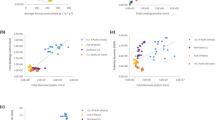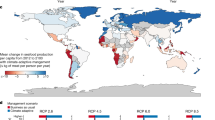Abstract
Offshore mariculture could enable increased seafood production and economic development while alleviating pressure on coastal ecosystems and wild fisheries. In the Caribbean, however, an integrated assessment of the ecological and economic potential for mariculture in the region is lacking. We assess site suitability and develop a spatial bioeconomic model to predict yields and profits for offshore cobia (Rachycentron canadum) mariculture across 30 jurisdictions in the Caribbean. We find that (1) approximately 1.4% of the study area may be technically feasible; (2) the model could avoid conflicts with other uses and sensitive habitats and protected areas; and (3) the model could be economically profitable, with the potential to produce almost half the amount of seafood that is currently harvested from wild fisheries globally. Here, we show that potential farm-scale production and profitability vary across and within countries and that accounting for the foreign investment risk associated with a country will impact estimated farm profitability.
This is a preview of subscription content, access via your institution
Access options
Access Nature and 54 other Nature Portfolio journals
Get Nature+, our best-value online-access subscription
$29.99 / 30 days
cancel any time
Subscribe to this journal
Receive 12 digital issues and online access to articles
$119.00 per year
only $9.92 per issue
Buy this article
- Purchase on Springer Link
- Instant access to full article PDF
Prices may be subject to local taxes which are calculated during checkout




Similar content being viewed by others
Code availability
Codes are available through github (https://github.com/lennon-thomas/Carib_aqua_16).
Data availability
The datasets generated and analysed in this study are available from the authors upon request.
References
The state of the world’s fisheries and aquaculture. In Contributing to Food Security and Nutrition for All (FAO, 2016).
Kobayashi, M. et al. Fish to 2030: the role and opportunity for aquaculture. Aquac. Econ. Manage. 19, 282–300 (2015).
Costello, C. et al. Global fishery prospects under contrasting management regimes. Proc. Natl Acad. Sci. USA 113, 5125–5129 (2016).
Merino, G. et al. Can marine fisheries and aquaculture meet fish demand from a growing human population in a changing climate? Global Environ. Change 22, 795–806 (2012).
Froehlich, H. E., Smith, A., Gentry, R. R. & Halpern, B. S. Offshore aquaculture: I know it when I see it. Front. Mar. Sci. 4, 154 (2017).
Holmer, M. Environmental issues of fish farming in offshore waters: perspectives, concerns and research needs. Aquac. Environ. Interact. 1, 57–70 (2010).
Van Wyk, P. & Davis, M. Integrating aquaculture into Caribbean development: selection of marine species. In Proc. 57th Gulf and Caribbean Fisheries Institute 917–928 (2006).
Creswell, L. The history of aquaculture in the Caribbean through presentations from 1948–2007. In Proc. 60th Gulf and Caribbean Fisheries Institute 62–64 (2008).
Study on the Potential of Fish Farming in the Caribbean CRFM Technical and Advisory Document 2014/3 65 (CRFM, 2014).
Pérez-Ramírez, M. Climate change and fisheries in the Caribbean. In Climate Change Impacts on Fisheries and Aquaculture (eds Phillips, B. F. & Pérez-Ramírez, M.) 639–662 (John Wiley, West Sussex, 2017).
Lovatelli, A., Aguilar-Manjarrez, J. & Soto, D. Expanding Mariculture Farther Offshore: Technical, Environmental, Spatial and Governance Challenges Technical Workshop 73 (FAO Fisheries and Aquaculture Department, 2013).
Alvarez-Lajonchère, L. & Ibarra-Castro, L. Aquaculture species selection method applied to marine fish in the Caribbean. Aquaculture 408–409, 20–29 (2013).
Gentry, R. R. et al. Offshore aquaculture: spatial planning principles for sustainable development. Ecol. Evol. 7, 733–743 (2017).
Benetti, D. et al. Can offshore aquaculture of carnivorous fish be sustainable? Case studies from the Caribbean. World Aquac. 37, 44–47 (2006).
Gentry, R. R. et al. Mapping the global potential for marine aquaculture. Nat. Ecol. Evol. 1, 1317–1324 (2017).
Benetti, D. D., Benetti, G. I., Rivera, J. A., Sardenberg, B. & O’Hanlon, B. Site selection criteria for open ocean aquaculture. Marine Technol. Soc. J. 44, 22–35 (2010).
Benetti, D. D. et al. Growth rates of cobia (Rachycentron canadum) cultured in open ocean submerged cages in the Caribbean. Aquaculture 302, 195–201 (2010).
Bezerra, T. R. Qde et al. Economic analysis of cobia (Rachycentron canadum) cage culture in large- and small-scale production systems in Brazil. Aquac. Int. 24, 609–622 (2016).
Lipton, D. W. & Kim, D. H. Assessing the economic viability of offshore aquaculture in Korea: an evaluation based on rock bream, Oplegnathus fasciatus, production. J. World Aquac. Soc. 38, 506–515 (2007).
Kam, L. E., Leung, P. & Ostrowski, A. C. Economics of offshore aquaculture of Pacific threadfin (Polydactylus sexfilis) in Hawaii. Aquaculture 223, 63–87 (2003).
Kapetsky, J. M., Aguilar-Manjarrez, J. & Jenness, J. A Global Assessment of Potential for Offshore Mariculture Development from a Spatial Perspective Technical Paper (FAO Fisheries and Aquaculture, 2013).
Naylor, R. L. et al. Feeding aquaculture in an era of finite resources. Proc. Natl Acad. Sci. USA 106, 15103–15110 (2009).
Denlinger, B. L. Testing Aquaculture Performance of Juvenile Cobia, Rachycentron Canadum, Using Diets Containing Differing Percentages of Protein and Fat. MA Thesis, Division of Marine Affairs and Policy, Univ. of Miami (2007).
Stelzenmüller, V. et al. Aquaculture Perspective of Multi-Use Sites in the Open Ocean 131–148 (Springer, Cham, 2017).
Shamshak, G. L. & Anderson, J. L. Dynamic stochastic adaptive bioeconomic model of offshore bluefin tuna aquaculture. Aquac. Econ. Manage. 13, 155–175 (2009).
Kaiser, M. J., Yu, Y. & Snyder, B. Economic feasibility of using offshore oil and gas structures in the Gulf of Mexico for platform-based aquaculture. Marine Policy 34, 699–707 (2010).
Lester, S. E. et al. Marine spatial planning makes room for offshore aquaculture in crowded coastal waters. Nat. Commun. 9, 945 (2018).
Patil, P. G., Virdin, J., Diez, S. M., Roberts, J. & Singh, A. Toward a Blue Economy: A Promise for Sustainable Growth in the Caribbean (World Bank, Washington DC, 2016).
Tlusty, M. F. et al. Co-occurrence mapping of disparate data sets to assess potential aquaculture sites in the Gulf of Maine. Rev. Fisher. Sci. Aquac. https://doi.org/10.1080/23308249.2017.1343798 (2017).
Klinger, D. & Naylor, R. Searching for solutions in aquaculture: charting a sustainable course. Ann. Rev. Environ. Resour. 37, 247–276 (2012).
Froehlich, H. E., Jacobsen, N. S., Essington, T. E., Clavelle, T. & Halpern, B. S. Avoiding the ecological limits of forage fish for fed aquaculture. Nature Sust. 1, 298–303 (2018).
Asche, F. Farming the sea. Marine Resour. Econ. 23, 527–547 (2008).
Huang, C.-T., Miao, S., Nan, F.-H. & Jung, S.-M. Study on regional production and economy of cobia Rachycentron canadum commercial cage culture. Aquac. Int. 19, 649–664 (2011).
Petersen, E. H. et al. Bioeconomics of cobia culture in Vietnam. Aquac. Econ. Manage. 18, 28–44 (2014).
Palmer, R., Rombenso, A., Araujo, A. D. & Sampaio, L. Expert topic: Cobia (International Aquafeed, 2015).
Jin, D., Kite-Powell, H. & Hoagland, P. Risk assessment in open-ocean aquaculture: a firm-level investment-production model. Aquac. Econ. Manage. 9, 369–387 (2005).
Lipton, D. W. & Kim, D. H. Accounting for economic risk and uncertainty in offshore aquaculture: A case study of Korean rock bream (Oplegnathus fasciats) production. Bull. Fish. Res. Agency 29, 93–102 (2010).
Price, C. & Beck-Stimpert, J. Best Management Practices for Marine Cage Culture Operations in the US Caribbean (Gulf and Caribbean Fisheries Institute, 2014).
Corbin, J. S., Holmyard, J. & Lindell, S. in Aquaculture Perspective of Multi-Use Sites in the Open Ocean (eds Buck, B. H. & Langan, R.) 187–229 (Springer International Publishing, Cham, 2017).
Open Ocean (Open Blue Cobia, 2018); https://www.openblue.com/
Maritime Boundaries Geodatabase: Maritime Boundaries and Exclusive Economic Zones (200NM), v.10 (Flanders Marine Institute, accessed 14 March 2016); http://www.vliz.be/en/imis?dasid=5465&doiid=312
Fredriksson, D. W. et al. The design and analysis of a four-cage grid mooring for open ocean aquaculture. Aquac. Eng. 32, 77–94 (2004).
Sims, N. A. In Expanding Mariculture Farther Offshore: Technical, Environmental, Spatial and Governance Challenges Technical Workshop (eds Lovatelli, A. et al.) 263–296 (FAO Fisheries and Aquaculture Department, Orbetello, 2013).
Fishery Management Plan for Regulating Offshore Marine Aquaculture in the Gulf of Mexico (Gulf of Mexico Fishery Management Council, National Oceanic and Atmospheric Administration, 2009).
Brett, J. R. in Fish Physiology (eds Hoar, W. S. et al.) Ch. 8 (Academic Press, New York, 1979).
Tidwell, J. A. Aquaculture Production Systems (John Wiley & Sons, Oxford, 2012).
NASA MODIS-Terra Daily 4 km Sea Surface Temperature Data (NASA Goddard Space Flight Center, Ocean Ecology Laboratory & Ocean Biology Processing Group, 2014).
Klinger, D. H., Levin, S. A. & Watson, J. R. The growth of finfish in global open-ocean aquaculture under climate change. Proc. R. Soc. B 284, 20170834 (2017).
Knapp, G. In Offshore Aquaculture in the United States: Economic Considerations, Implications & Opportunities (ed. Rubino, M.) Technical Memorandum NMFS F/SPO-103 263 (NOAA, 2008).
Rubino, M. Offshore Aquaculture in the United States: Economic Considerations, Implications & Opportunities Technical Memorandum NMFS F/SPO-103 263 (NOAA, 2008).
Halwart, M., Soto, D. & Arthur J. R. Cage Aquaculture: Regional Reviews and Global Overview Technical Paper 498 (FAO, 2007).
Bhalla, B. How corporations should weigh up country risk. Euromoney June, 6672 (1983).
Stanley, M. T. Cost of capital in capital budgeting for foreign direct investment. Manag. Finance 16, 13–16 (1990).
Ruiz Campo, S. & Zuniga-Jara, S. Reviewing capital cost estimations in aquaculture. Aquac. Econom. Manag. 22, 72–93 (2018).
Pelletier, N., Klinger, D. H., Sims, N. A., Yoshioka, J.-R. & Kittinger, J. N. Nutritional attributes, substitutability, scalability, and environmental intensity of an illustrative subset of current and future protein sources for aquaculture feeds: joint consideration of potential synergies and trade-offs. Environ. Sci. Technol. 10, 5532–5544 (2018).
Acknowledgements
Funding for the project was provided by the Waitt Foundation. We thank C. Costello for his advice and input on our economic model; J. Afflerbach for support in conducting spatial analysis and mapping; R. Gentry for her help in developing suitability analysis methods; E. Ruff for her research on aquaculture policy in the Caribbean; and J. Flower for his Caribbean expertise and help with ground-truthing data. S.E.L. acknowledges support from the National Science Foundation under grant no. 1759559.
Author information
Authors and Affiliations
Contributions
All authors contributed to research design and interpretation of results, and provided supporting information for the project. The TPC modelling was conducted by D.K., the suitability analysis and economic model was conducted by T.C. and L.T., and L.T., S.L. and T.C. wrote the paper.
Corresponding author
Ethics declarations
Competing interests
The authors declare no competing interests.
Additional information
Publisher’s note: Springer Nature remains neutral with regard to jurisdictional claims in published maps and institutional affiliations.
Supplementary information
Supplementary Information
Supplementary Methods, Supplementary Figures 1–3, Supplementary Tables 1–7, Supplementary References 1–31
Rights and permissions
About this article
Cite this article
Thomas, L.R., Clavelle, T., Klinger, D.H. et al. The ecological and economic potential for offshore mariculture in the Caribbean. Nat Sustain 2, 62–70 (2019). https://doi.org/10.1038/s41893-018-0205-y
Received:
Accepted:
Published:
Issue Date:
DOI: https://doi.org/10.1038/s41893-018-0205-y
This article is cited by
-
Spatiotemporal variation of China’s mariculture potential under climate change
Reviews in Fish Biology and Fisheries (2024)
-
Mapping the potential for offshore aquaculture of salmonids in the Yellow Sea
Marine Life Science & Technology (2022)
-
Food Security Challenges and Options in the Caribbean: Insights from a Scoping Review
Anthropocene Science (2022)
-
A 20-year retrospective review of global aquaculture
Nature (2021)
-
Farming fish in the sea will not nourish the world
Nature Communications (2020)



